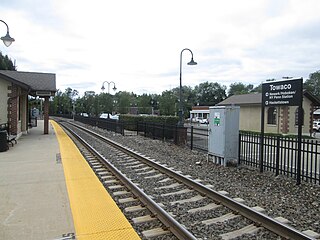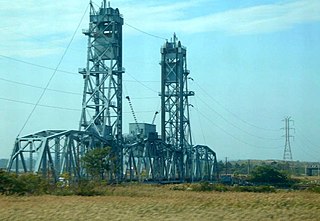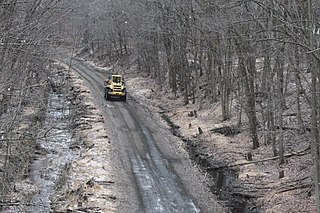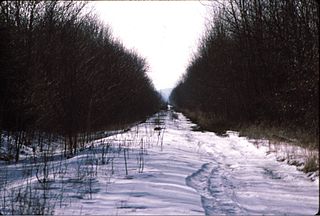
The Delaware, Lackawanna and Western Railroad was a U.S. Class 1 railroad that connected Buffalo, New York, and Hoboken, New Jersey, a distance of about 400 miles (640 km). Incorporated in Pennsylvania in 1853 primarily for the purpose of providing a connection between the anthracite coal fields of Pennsylvania's Coal Region and the large markets for coal in New York City, the railroad gradually expanded both East and West, eventually linking Buffalo with New York City. Like most coal-focused railroads in Northeastern Pennsylvania, the DL&W was profitable during the first half of the twentieth century, but its margins were gradually hurt by declining Pennsylvania coal traffic, especially following the 1959 Knox Mine Disaster and competition from trucks following the expansion of the Interstate Highway System in the 1960s and 1970s. In 1960, the DL&W merged with rival Erie Railroad to form the Erie Lackawanna Railroad that would be taken over by Conrail in 1976.

The Lackawanna Cut-Off was a rail line built by the Delaware, Lackawanna & Western Railroad (DL&W). Constructed from 1908 to 1911, the line was part of a 400-mile (640 km) main line between Hoboken, New Jersey, and Buffalo, New York. It ran west for 28.6 miles (46.0 km) from Port Morris Junction in Port Morris, New Jersey – near the south end of Lake Hopatcong, about 45 miles (72 km) west-northwest of New York City – to Slateford Junction in Slateford, Pennsylvania, near the Delaware Water Gap.

Mountain Station is a New Jersey Transit station in South Orange, Essex County, New Jersey, United States, along the Morris and Essex. The station, built in 1915, was designed by Frank J. Nies. It has been listed in the New Jersey Register of Historic Places and National Register of Historic Places since 1984 and is part of the Operating Passenger Railroad Stations Thematic Resource.

Mount Arlington is a commuter railroad station for New Jersey Transit. Located in the borough of Mount Arlington, Morris County, New Jersey, United States, the station is located next to interchange 30 on Interstate 80. The station serves as a park-and-ride for commuters to catch trains for Hoboken Terminal and New York Penn Station. Trains use the Montclair-Boonton Line and Morristown Line to serve locales between Hackettstown and the eastern terminals. Lakeland Bus Lines also services Mount Arlington station. The station is handicapped accessible as part of the Americans with Disabilities Act of 1990. The station features two side platforms and two tracks with elevators.

Lake Hopatcong is a commuter railroad station for New Jersey Transit. The station, located in the community of Landing in Roxbury Township, Morris County, New Jersey, United States, serves trains for the Montclair-Boonton Line and Morristown Line at peak hours and on holiday weekends. Service from Lake Hopatcong provides to/from Hackettstown to New York Penn Station and Hoboken Terminal. The stop is located on the tracks below Landing Road next to the eponymous Lake Hopatcong. The station consists of one active and one abandoned side platform, along with a shelter on the active platform. There is no accessibility for handicapped persons under the Americans with Disabilities Act of 1990.

Mount Olive is a NJ Transit station in Mount Olive, New Jersey, located in the International Trade Center. The station, located on the side of Waterloo Village Road, services trains for both the Montclair-Boonton Line and the Morristown Line along trackage owned by Norfolk Southern. The line is not electrified from Hackettstown to Dover, where passengers can transfer to an electric Morristown Line train via Summit or a diesel Montclair-Boonton train via Wayne and Montclair. Trains along both lines head to Hoboken Terminal in Hoboken, New Jersey or New York Penn Station at 34th Street in New York City, although Montclair-Boonton trains require a transfer at Montclair State University or Newark Broad Street for electrified service to New York.

Towaco is a train station on New Jersey Transit's Montclair-Boonton Line in the Towaco section of Montville Township, New Jersey. The station is located on U.S. Route 202 and Whitehall Roads in Montville.

Roseville Avenue was a transfer station on New Jersey Transit's Morris & Essex Lines in Newark, New Jersey, United States. The station was built by the Delaware, Lackawanna and Western Railroad in 1903 as part of a project to lower the tracks below the road surface to eliminate grade crossings. It serviced Newark's Roseville neighborhood. It once had two tracks on the Lackawanna mainline and two low-wall platforms, with an additional platform along the Montclair Branch. The station remained in service during most of the 20th century, until New Jersey Transit closed the station on September 16, 1984.

The Paulinskill Viaduct, also known as the Hainesburg Viaduct, is a reinforced concrete railroad bridge that crosses the Paulins Kill in Knowlton Township, New Jersey. When completed in 1910, it was the largest reinforced concrete structure in the world.

Upper Hack Lift is a lift bridge carrying the New Jersey Transit Main Line across the Hackensack River at mile 6.9 between Secaucus, New Jersey and Lyndhurst.

Delawanna is a commuter rail station for New Jersey Transit in the Delawanna section of Clifton, Passaic County, New Jersey. The station, located at the intersection of Delawanna Avenue and Oak Street, serves trains on New Jersey Transit's Main Line, serving Hoboken Terminal on the east end and Suffern and Port Jervis stations on the west end in New York. Delawanna station has two low-level side platforms with a shelter on the inbound side, lacking access for the physically disabled under the Americans With Disabilities Act of 1990.

Lyndhurst is a New Jersey Transit rail station located off of New York Avenue in Lyndhurst, New Jersey. The station is one of two in Lyndhurst, the other being Kingsland station. The Lyndhurst station is located at milepost 8.2 on the Main Line.
The Boonton Branch refers to the railroad line in New Jersey that was completed in 1870 and ran 34 miles (54.8 km) from Hoboken to East Dover Junction as part of the Morris & Essex Railroad (M&E). Although the branch hosted commuter trains, the line was primarily built as a freight bypass line. The term "branch", therefore, is somewhat of a misnomer since the Boonton Branch was built to higher mainline standards than the Morristown Line, the line that it bypassed. As a result, the Boonton Branch better meets the definition of a "cut-off" rather than a branch. Some of the towns that the Boonton Branch passed through included Lyndhurst, Passaic, Clifton, Paterson, Wayne, Lincoln Park, Mountain Lakes, and its namesake, Boonton.

The Landing Masonry Bridge, also designated Bridge 44.53, is a 136-foot (41 m) stone structure built in 1907 by the Delaware, Lackawanna and Western Railroad in Landing, New Jersey, United States. Located 44.53 miles up the rail line from Hoboken Terminal, the bridge carries the two-lane Morris County Route 631 over the Morristown Line and Montclair-Boonton Line railroad tracks maintained by New Jersey Transit, and sits several hundred feet north of NJT's Lake Hopatcong Station. Now deteriorated and structurally deficient, it is to be replaced with a four-lane bridge by NJT and the New Jersey Department of Transportation.

Slateford Junction was a railway junction in the small town of Slateford, Pennsylvania, built to connect the existing mainline of the Lackawanna Railroad — the so-called Old Road — with the new Lackawanna Cut-Off. It operated from 1911 until 1979.

The Pequest Fill is a large railroad embankment on the Lackawanna Cut-Off in northwestern New Jersey, touted at its 1911 completion as the largest railroad fill in the world.

McMickle Cut is the longest cut on the Lackawanna Cut-Off railroad line in northwest New Jersey. It was built between 1908 and 1911 by contractor Timothy Burke between mileposts 47.1 and 48.1 where Stanhope and Byram Township meet. Some 600,000 cubic yards of material was removed by dynamite and other methods to make the cut, which is 1.04 miles long, has an average depth of 29 feet, and a maximum depth of 54 feet.

Waltz & Reece Cut is the deepest cut on the Lackawanna Cut-Off railroad line in northwest New Jersey. The cut is 0.68 miles (1.1 km) long, has an average depth of 37 feet, and a maximum depth of 114 feet.

Greendell is one of three original railway stations built by the Delaware, Lackawanna & Western Railroad (DL&W) along its Lackawanna Cut-Off line in northwestern New Jersey. The station, which still stands in Green Township at milepost 57.6 on the Cut-Off, began operations on December 23, 1911, one day before the line itself opened and the first revenue train arrived.

Andover is a planned New Jersey Transit passenger railroad station in Andover Township, in Sussex County, New Jersey, United States, providing service on its Lackawanna Cut-Off line. The line remains under construction. The station will be built at a site on Andover's Roseville Road, about 1.1 miles (1.8 km) from U.S. Route 206 and about 0.9 miles (1.4 km) from County Route 517. On the rail line, it will be located about 7.3 miles (11.7 km) west of Port Morris Junction.





















